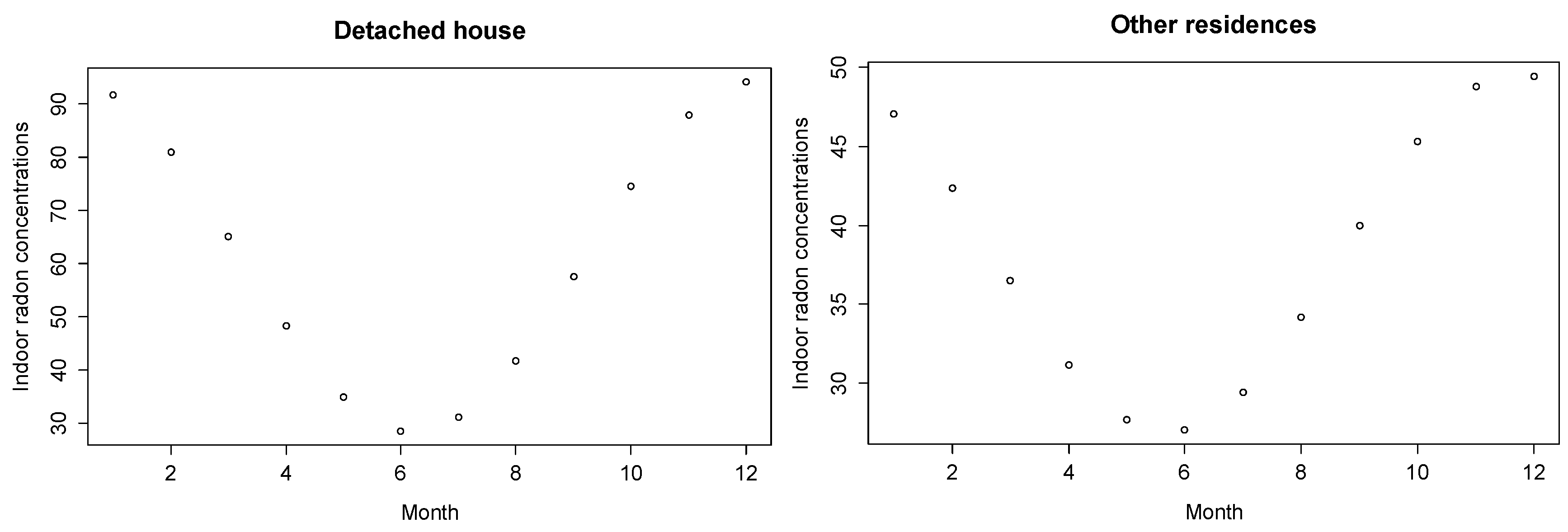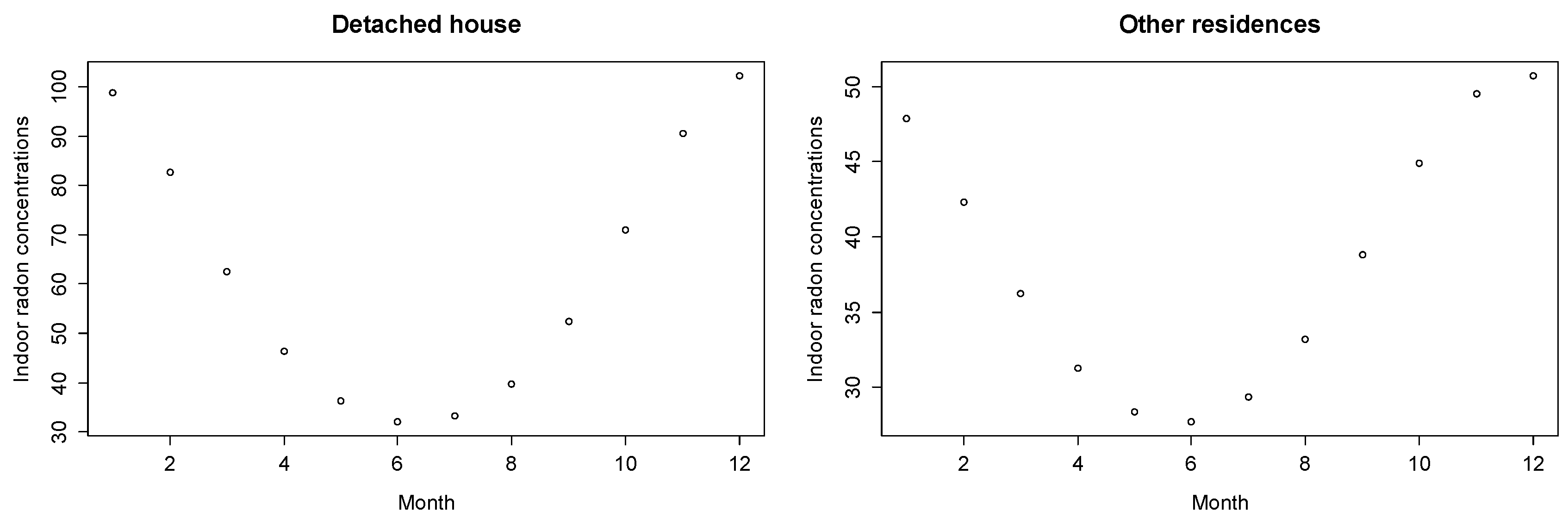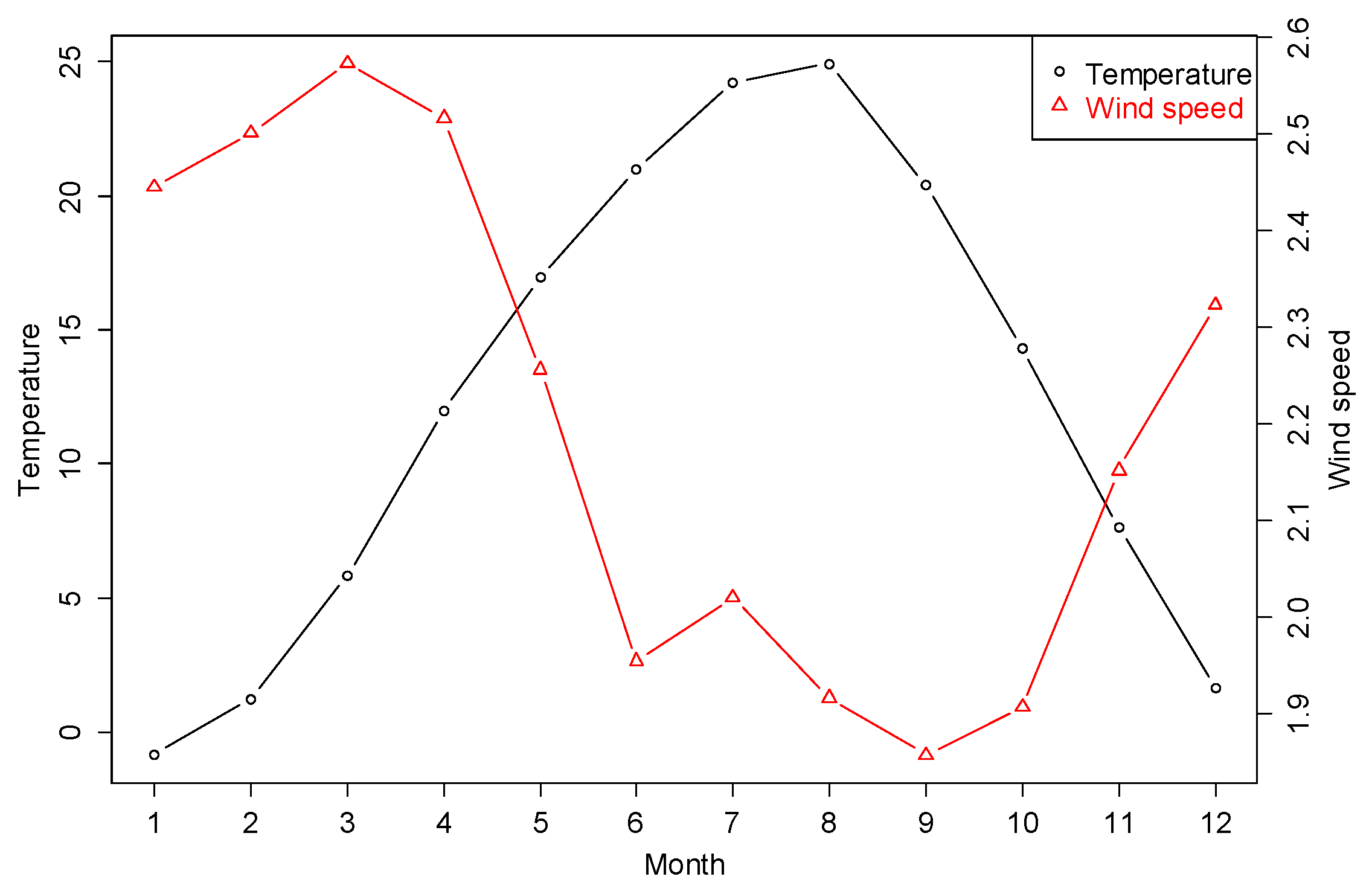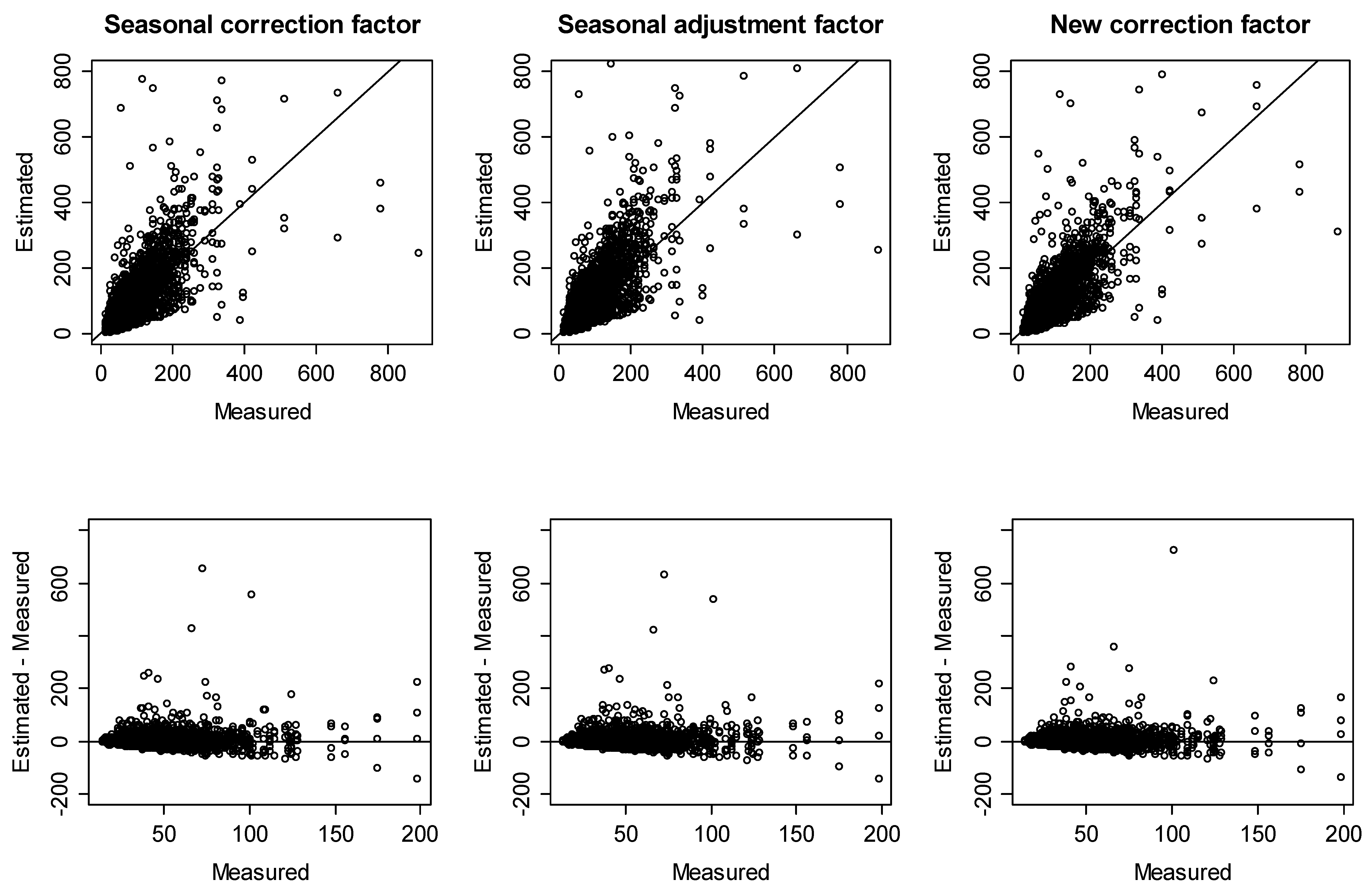Estimation of Seasonal Correction Factors for Indoor Radon Concentrations in Korea
Abstract
:1. Introduction
2. Materials and Methods
2.1. Seasonal Variation of Indoor Radon Concentrations
2.2. Seasonal Correction Factors
2.3. Seasonal Adjustment Factor
2.4. New Correction Factors
3. Results and Discussion
3.1. Estimation of Seasonal Correction Factors
3.2. Applying the Seasonal Correction Factors to Data
3.3. The Annual Effective Dose Model
4. Conclusions
Author Contributions
Funding
Conflicts of Interest
References
- World Health Organization (WHO). Who Handbook on Indoor Radon: A Public Health Perspective. Available online: http://apps.who.int/iris/bitstream/10665/44149/1/9789241547673_eng.pdf (accessed on 4 October 2018).
- Webb, G.A.M. Exposure to Radon. Radiat. Prot. Dosim. 1992, 42, 191–195. [Google Scholar]
- Lubin, J.H.; Boice, J.J.D. Lung cancer risk from residential radon: Meta-analysis of eight epidemiologic studies. J. Nat. Cancer Inst. 1997, 89, 49–57. [Google Scholar] [CrossRef] [PubMed]
- Neuberger, J.S.; Gesell, T.F. Residential radon exposure and lung cancer: Risk in nonsmokers. Health Phys. 2002, 83, 1–18. [Google Scholar] [CrossRef] [PubMed]
- Lázár, I.; Tóth, E.; Marx, G.; Cziegler, I.; Köteles, G.J. Effects of residential radon on cancer incidence. J. Radioanal. Nucl. Chem. 2003, 258, 519–524. [Google Scholar] [CrossRef]
- United Nations Scientific Committee on the Effects of Atomic Radiation (UNSCEAR). Sources and Effects of Ionizing Radiation, UNSCEAR 2000 Report to the General Assembly with Scientific Annexes; United Nations: New York, NY, USA, 2000. [Google Scholar]
- Wrixon, A.D.; Green, B.M.R.; Lomas, P.R.; Miles, J.C.H.; Cliff, K.D.; Francis, E.A.; Driscoll, C.M.H.; James, A.C.; O’Riordan, M.C. Natural Radiation Exposure in UK Dwellings; National Radiological Protection Board: London, UK, 1988. [Google Scholar]
- Pinel, J.; Fearn, T.; Darby, S.C.; Miles, J.C.H. Seasonal correction factors for indoor radon measurements in the United Kingdom. Radiat. Prot. Dosim. 1995, 58, 127–132. [Google Scholar]
- Krewski, D.; Mallick, R.; Zielinski, J.M.; Letourneau, E.G. Modeling seasonal variation in indoor radon concentrations. concentrations J. Expo. Anal. Environ. Epidemiol. 2005, 15, 234–243. [Google Scholar] [CrossRef] [PubMed]
- Denman, A.R.; Crockett, R.G.; Groves-Kirkby, C.J.; Phillips, P.S.; Gillmore, G.K.; Woolridge, A.C. The value of Seasonal Correction Factors in assessing the health risk from domestic radon: A case study in Northamptonshire, UK. Environ. Int. 2007, 33, 34–44. [Google Scholar] [CrossRef] [PubMed]
- Miles, J.C.; Howarth, C.B.; Hunter, N. Seasonal variation of radon concentrations in UK homes. J. Radiol. Prot. 2012, 32, 275–287. [Google Scholar] [CrossRef] [PubMed]
- Daraktchieva, Z. New correction factors based on seasonal variability of outdoor temperature for estimating annual radon concentrations in UK. Radiat. Prot. Dosim. 2017, 175, 65–74. [Google Scholar] [CrossRef] [PubMed]
- Baysson, H.; Billon, S.; Laurier, D.; Rogel, A.; Tirmarche, M. Seasonal correction factors for estimating radon exposure in dwellings in France. Radiat. Prot. Dosim. 2003, 104, 245–252. [Google Scholar] [CrossRef]
- Burke, O.; Long, S.; Murphy, P.; Organo, C.; Fenton, D.; Colgan, P.A. Estimation of seasonal correction factors through Fourier decomposition analysis—A new model for indoor radon levels in Irish homes. J. Radiol. Prot. 2010, 30, 433–443. [Google Scholar] [CrossRef] [PubMed]
- Kozak, K.; Mazur, J.; Kozlowska, B.; Karpinska, M.; Przylibski, T.A.; Mamont-Ciesla, K.; Grzadziel, D.; Stawarz, O.; Wysocka, M.; Dorda, J.; et al. Correction factors for determination of annual average radon concentration in dwellings of Poland resulting from seasonal variability of indoor radon. Appl. Radiat. Isot. 2011, 69, 1459–1465. [Google Scholar] [CrossRef] [PubMed]
- Lee, C.M.; Kang, D.R.; Koh, S.B.; Cho, Y.S.; Lee, D.J.; Lee, S.B. Development of predictive model for annual mean radon concentration for assessment of annual effective dose of radon exposure. J. Environ. Sci. Int. 2016, 25, 1107–1114. [Google Scholar] [CrossRef]
- Groves-Kirkby, C.J.; Crockett, R.G.; Denman, A.R.; Phillips, P.S. A critical analysis of climatic influences on indoor radon concentrations: Implications for seasonal correction. J. Environ. Radioact. 2015, 148, 16–26. [Google Scholar] [CrossRef] [PubMed]
- Miles, J.C. Temporal variation of radon levels in houses and implications for radon measurement strategies. Radiat. Prot. Dosim. 2001, 93, 369–376. [Google Scholar] [CrossRef]





| Seasonal Radon Concentration (Bq/m3) | ||||||||||
|---|---|---|---|---|---|---|---|---|---|---|
| N | AM | SD | GM | GSD | Min | Q1 | Median | Q3 | Max | |
| KINS (2005) | ||||||||||
| Spring | 2518 | 53.9 | 55.5 | 41.8 | 1.9 | 8.5 | 25.9 | 40.7 | 62.9 | 1073.0 |
| Summer | 2518 | 32.8 | 26.9 | 28.3 | 1.6 | 6.0 | 18.5 | 26.5 | 37.0 | 558.7 |
| Fall | 2518 | 69.5 | 78.1 | 55.2 | 1.9 | 11.1 | 37.0 | 51.8 | 77.7 | 1835.0 |
| Winter | 2518 | 86.1 | 135.3 | 60.5 | 2.1 | 4.0 | 37.0 | 55.5 | 92.5 | 3249.0 |
| NIER (2010–2011) | ||||||||||
| Spring | 633 | 53.9 | 49.7 | 43.0 | 1.9 | 5.7 | 27.4 | 40.8 | 61.4 | 651.2 |
| Summer | 633 | 47.9 | 26.5 | 43.2 | 1.5 | 9.4 | 32.6 | 42.0 | 54.9 | 333.2 |
| Fall | 633 | 107.4 | 93.9 | 86.4 | 1.8 | 20.0 | 57.3 | 77.0 | 119.0 | 1172.0 |
| Winter | 633 | 124.1 | 135.9 | 88.1 | 2.2 | 7.1 | 50.5 | 77.8 | 140.0 | 1509.0 |
| Winter/Summer Ratio | |||||||||||
|---|---|---|---|---|---|---|---|---|---|---|---|
| KINS | NIER | Total | |||||||||
| N | AM | GM | N | AM | GM | N | AM | GM | |||
| Detached house | Korean-style | 1347 | 3.59 | 2.74 | 117 | 3.02 | 2.18 | 1761 | 3.57 | 2.70 | |
| Western-style | 297 | 3.68 | 2.75 | ||||||||
| Other residences | Apartment | 961 | 1.83 | 1.55 | 106 | 1.29 | 1.14 | 1390 | 1.85 | 1.56 | |
| Row house | 210 | 2.28 | 1.91 | 84 | 1.61 | 1.46 | |||||
| Multiplex house | 29 | 1.83 | 1.60 | ||||||||
| Measured (Bq/m3) | Estimated (Bq/m3) | Percent Error a (%error) | ||
|---|---|---|---|---|
| Detached house | Spring | 50.60 | 49.39 | 2.39 |
| Summer | 32.52 | 33.73 | −3.73 | |
| Fall | 74.56 | 73.35 | 1.62 | |
| Winter | 87.80 | 89.01 | −1.38 | |
| Other residences | Spring | 33.26 | 31.76 | 4.52 |
| Summer | 28.69 | 30.19 | −5.24 | |
| Fall | 46.21 | 44.71 | 3.25 | |
| Winter | 44.77 | 46.27 | −3.36 |
| Measured (Bq/m3) | Estimated (Bq/m3) | Percent Error a (%error) | ||
|---|---|---|---|---|
| Detached house | Spring | 50.60 | 47.19 | 4.52 |
| Summer | 32.52 | 34.86 | −5.24 | |
| Fall | 74.56 | 69.54 | 3.25 | |
| Winter | 87.80 | 94.13 | −3.36 | |
| Other residences | Spring | 33.26 | 31.80 | 4.39 |
| Summer | 28.69 | 30.01 | −4.59 | |
| Fall | 46.21 | 44.19 | 4.39 | |
| Winter | 44.77 | 46.83 | −4.59 |
| Season | Month | Detached House | Other Residences | ||||
|---|---|---|---|---|---|---|---|
| Spring | March | 0.94 | 1.13 | 1.24 | 0.97 | 1.13 | 1.20 |
| April | 1.01 | 1.01 | |||||
| May | 1.09 | 1.04 | |||||
| Summer | June | 1.14 | 1.76 | 1.82 | 1.07 | 1.31 | 1.27 |
| July | 1.21 | 1.10 | |||||
| August | 1.13 | 1.07 | |||||
| Fall | September | 1.02 | 0.77 | 0.84 | 1.01 | 0.81 | 0.86 |
| October | 0.95 | 0.97 | |||||
| November | 0.91 | 0.95 | |||||
| Winter | December | 0.90 | 0.65 | 0.69 | 0.95 | 0.83 | 0.83 |
| January | 0.91 | 0.95 | |||||
| February | 0.91 | 0.95 | |||||
| N | Difference Limit (Bq/m3), p-Value | |||||||||
|---|---|---|---|---|---|---|---|---|---|---|
| 10 | p-Value | 20 | p-Value | 30 | p-Value | 40 | p-Value | |||
| Detached house | Seasonal correction factor | 7044 | 45.5 | 0.498 | 70.6 | 0.618 | 81.4 | 0.879 | 87.3 | 1.000 |
| Seasonal adjustment factor | 7044 | 43.2 | 0.038 | 67.1 | 0.000 | 78.5 | 0.000 | 85.3 | 0.001 | |
| New correction factor | 7044 | 44.9 | — | 70.2 | — | 81.5 | — | 87.3 | — | |
| Other residences | Seasonal correction factor | 5560 | 65.7 | 0.001 | 88.9 | 0.062 | 95.1 | 0.760 | 97.2 | 0.727 |
| Seasonal adjustment factor | 5560 | 64.7 | 0.020 | 88.5 | 0.265 | 94.8 | 0.670 | 97.0 | 0.278 | |
| New correction factor | 5560 | 62.6 | — | 87.8 | — | 95.0 | — | 97.3 | — | |
© 2018 by the authors. Licensee MDPI, Basel, Switzerland. This article is an open access article distributed under the terms and conditions of the Creative Commons Attribution (CC BY) license (http://creativecommons.org/licenses/by/4.0/).
Share and Cite
Park, J.H.; Lee, C.M.; Lee, H.Y.; Kang, D.R. Estimation of Seasonal Correction Factors for Indoor Radon Concentrations in Korea. Int. J. Environ. Res. Public Health 2018, 15, 2251. https://doi.org/10.3390/ijerph15102251
Park JH, Lee CM, Lee HY, Kang DR. Estimation of Seasonal Correction Factors for Indoor Radon Concentrations in Korea. International Journal of Environmental Research and Public Health. 2018; 15(10):2251. https://doi.org/10.3390/ijerph15102251
Chicago/Turabian StylePark, Ji Hyun, Cheol Min Lee, Hyun Young Lee, and Dae Ryong Kang. 2018. "Estimation of Seasonal Correction Factors for Indoor Radon Concentrations in Korea" International Journal of Environmental Research and Public Health 15, no. 10: 2251. https://doi.org/10.3390/ijerph15102251
APA StylePark, J. H., Lee, C. M., Lee, H. Y., & Kang, D. R. (2018). Estimation of Seasonal Correction Factors for Indoor Radon Concentrations in Korea. International Journal of Environmental Research and Public Health, 15(10), 2251. https://doi.org/10.3390/ijerph15102251





